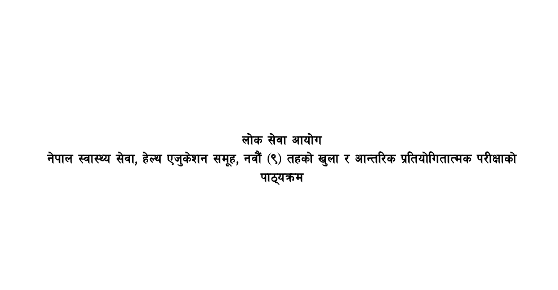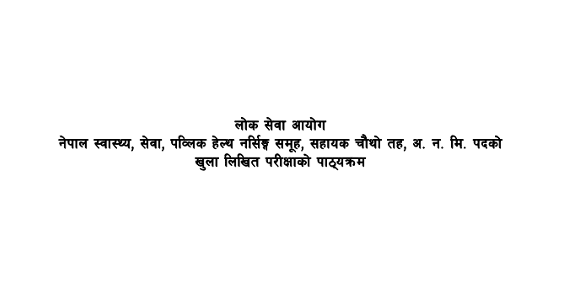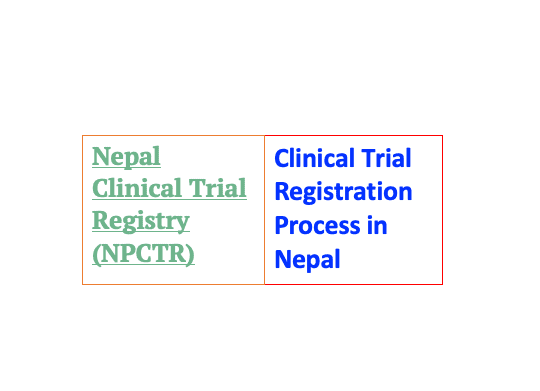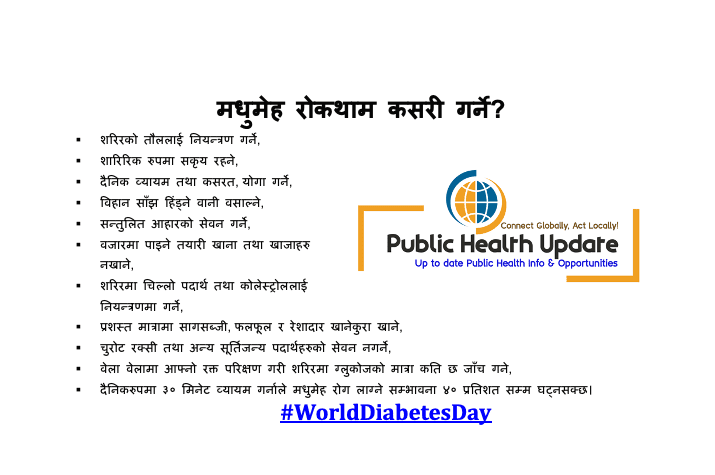Paper I General Subject
Part I: Management 50 marks
– 6 × 5 = 30 (Short answer)
– 2 × 10 = 20 (Long answer)
Part II: General Health Issues 50 marks
Full Marks: 100
No. Questions & Weightage
– 4 × 5 = 20 (Short answer)
– 3 × 10 = 30 (Long answer)
Time Allowed: 3 hours
Paper II: Technical Subject
Full Marks: 100
Time Allowed: 3 hours
No. Questions & Weightage
– 4 × 15 = 60 (Critical Analysis)
– 2 × 20 = 40 (Problem Solving)
Paper I General Subject (Management and General Health Issues)
Part I: Management
- Management: – concept, principles, functions, scope, role, level and skills of managers
- Hospital management
- Health manpower recruitment and development
- Participative management: concept, advantages and disadvantages, techniques of participation
- Time management: concept, advantages, and disadvantages
- Conflict management: concept, approaches to conflict, levels of conflict, causes of conflict and strategies for conflict management
- Stress management: concept, causes and sources of stress, techniques of stress management
- Appreciative inquiry: concept, basic principles and management
- Financial management: concept, approaches, budget formulation and implementation, auditing and topics related to fiscal management
- Human resource management: concept, functions and different aspects
- Planning: concept, principles, nature, types, instrument and steps
- Leadership: concept, functions, leadership styles, leadership and management effectiveness
- Coordination: concept, need, types, techniques, and approaches of effective coordination
- Communication: concept, communication process and barrier to effective communication, techniques for improving communication
Part II: General Health Issues
- Present Constitution of Nepal (health and welfare issues)
- National Health Policy, 2071
- Second long term health plan (1997-2017)
- Health services act 2053, health service regulation, 2055
- Organizational structure of Ministry of Health at National, Regional and District and Below
- International health agencies: role and responsibilities of WHO, UNICEF,
- UNFPA and interagency relationships
- Professional council and related regulations
- Medical ethics in general and its application
- Indigenous and traditional faith healing and health practices
- Supervision, types and its usage in health sector
- Monitoring and evaluation system in health
- Health management information system
- Health insurance and financing in health care
- Effects of environment in public health: air pollution, domestic pollution, noise
- pollution
- Importance of water, sanitation and hygiene in public health
- Effects of disaster in public health: deforestation, landslide, flood, earthquake and fire
- Health volunteers involvement in health service delivery
- Community involvement in health service delivery
- Counseling: – concept, type, importance and its application in health service delivery
Paper II: TECHNICAL SUBJECT
A. Introduction of Health Education and Health Promotion
1. Health Education
1.1. Meaning, philosophy, aim and principles of health education
1.2. Scope of health education- Individual, family, Community School, health care facilities, occupational setting
1.3. Role of health education in public health programs and primary health care services
1.4. Health Education for disaster prevention and management
2. Health Promotion
2.1. Meaning and definition of health promotion; issues and challenges for health development
2.2. Ottawa charter, Jakarta declaration and subsequent international conferences on health promotion
2.3. Setting Approach in Health Promotion
2.3.1. Health Promoting School – Meaning, concept and strategies (School Health Services, Healthful School Environment, Health Instruction and School Community Joint Actions)
2.3.1.1. Adolescent health and sex education
2.3.1.2. Life skill education (10 core skills)
2.3.2. Health Promoting Hospital
2.3.3. Health Promoting Workplace
2.3.4. Health Promoting Community
2.4 International and national commitment for health education and health promotion events – world health day, world no tobacco day and world AIDS day etc.
2.5. International treaties on health education and health promotion – Framework Convention on Tobacco (FCTC) etc.
2.6. Risk approach to health education and health promotion
B. Fundamentals for Health Education and Health Promotion
1. Communication in Health Education and Promotion
1.1. Meaning, principles, elements of communication
1.2. Theories and principles of mass communication
1.3. Factors for effective communication
1.4. Types of appeal for communication
1.5. Message and its characteristics
1.6. Communication methods
1.6.1. Individual – interview, counseling
1.6.2. Group – group discussion, demonstration, role play, seminar, workshop, symposium, panel discussion, drama (street performances)
1.6.3. Mass – Radio, TV, Newspaper, Movie, Exhibition
1.6.4. Folk – Folk song, folk dance, puppet show etc.
2. Sociology and Social Psychology in Health Education and Health Promotion
2.1. Meaning and relation between sociology, social psychology and anthropology in health education and health promotion
2.2. Perception, knowledge, attitude and behavior
2.3. Culture and its component
2.4. Community development and community organization – process and approaches
2.5. Change process and change agent
2.6. Group Dynamics and Group Process
3. Learning Theories – classical and modern theories of learning (Pavlov, Thorndike, Skinner, Kurtlewin, Kelman and Gestalts) and its application in health education and health promotion
4. Motivation and Health Belief Model – Maslow, Rosenstock, Kurt Lewin, Rogers, Festingers etc. for behaviour change model
5 Behaviour Change Communication
C. Media for Health Education and Health Promotion
1. Classification and nature of health education and health promotion Media
2. Mass media – Electronic and Print media (Radio, FM, Television, Newspaper, Posters, Pamphlets, Leaflet, Booklets, Magazines, Email, Internet, Web hosting .etc.)
3. Group and individual – projected, non-projected and 3 dimensional (Flip chart, Flannel graph, Flash card, Film strip, Slide, Video Film, Models, specimen, & real objects)
4. Media development format and process: Need assessment; setting target audience; developing and testing message concepts; developing draft or dummy materials; pre-testing of materials with respect to reason, process and methods; review and revision of materials; finalization, production and distribution of materials; dissemination of information, evaluation of its effect and continuity
5. Consideration for choosing media
6. Use of computers for Graphic designing and Photoshop for the production audio visual aids
D. Curriculum Development and Training
1. Curriculum development models, methods and processes
2. Teaching learning process and lesson plan
3. Teaching learning methods and media – preparation of teaching learning material such as Transparency, PowerPoint presentation etc. and use of OverHead Projector, LCD Projector, Slide and movie Projectors)
4. Non- formal education and Adult learning
E. Health Education and Health Promotion Program Planning, Implementation and Evaluation
1. Rationale and importance of a planned health education and health promotion programs at different levels
2. Overview of the national health education program and activities in Nepal at Central, Regional and District levels.
3. Role of NHEICC in health education and health promotion
4. Different health education program planning models – classical and modern (PIE, PRECEDE & PROCEED model for diagnosis, planning, monitoring and evaluation of health education and health promotion programs)
5. Health Education and Promotion Strategy Development
5.1. Situation Analysis
5.2. Approaches of Strategy Development
5.2.1. Advocacy
5.2.2. Social Mobilization/Social marketing/ Peer Education (Child to child) /Non formal education
5.2.3. Behaviour Change Communication
5.3. Segmenting Target Audience
5.4. Objective Setting
5.5. Deciding Message, Methods and Channel
5.6. Development of Action Plan with respect to activities, resources, place, time frame, responsibility and allies.
5.7. Monitoring and Evaluation
5.7.1. Monitoring of activities and events
5.7.2. Impact, effect and process evaluation
F. Health Education and Health Promotion Aspect of Major Public Health Programs
1. PHC Priority Essential Health Care Services – Reproductive Health, Child Health (Integrated Management of Childhood Illness, Immunization, Vitamin A and other Nutrition Programs); Communicable disease control – TB, HIV/AIDS, Vector born disease, Hepatitis B, Leprosy etc and rational use of drugs.
2. Non-communicable disease control program – risk assessment and control strategies and patient education
3. Environmental Health program
3.1. Major Environmental Issues and its contribution in morbidity, mortality and environmental degradation
3.2. Air pollution, its assessment and mitigation measures
3.3. Sources of water, water quality assurance and household purification
3.4. Solid waste and its management at community and household level
3.5. Human excreta disposal management
3.6. Fly and rodent control
4. Personal, domestic and community hygiene
5. Tobacco, drug abuse and Alcohol: effects, prevention and control
Syllabus
- Public Service Commission Syllabus Health Education Teaching Administrator
- Public Service Commission Syllabus for Health Education Technician
- Public Service Commission For ANM Syllabus
- Public Service Commission Syllabus for AHW
- Public Service Commission Syllabus Health Assistant
- Public Service Commission Syllabus for AHW
- Syllabus for Postgraduate Integrated Entrance Examination
- Syllabus for Public Health Licensing Examination 2073 – Nepal Health Professional Council
- Syllabus for Public Health Officer 7th Level Examination – Public Service Commission
Do you have a website? Looking for the best hosting provider? Here’s a discount code.
Latest Public Health Jobs
Latest Posts
- The 18th World Congress on Public Health (WCPH) 2026
- National workforce capacity for essential public health functions: Operational handbook for country-led contextualization and implementation
- World Conference on Lung Health Travel Grants 2025
- GIS Training Manual for Health Statistics
- WHO launches bold push to raise health taxes and save millions of lives
Thanks for visiting us.
Disclaimer: The resources, documents, guidelines, and information on this blog have been collected from various sources and are intended for informational purposes only. Information published on or through this website and affiliated social media channels does not represent the intention, plan, or strategies of an organization that the initiator is associated with in a professional or personal capacity, unless explicitly indicated.
If you have any complaints, information, or suggestions about the content published on Public Health Update, please feel free to contact us at blog.publichealthupdate@gmail.com.
#StayUpdated












